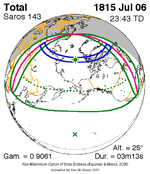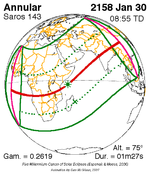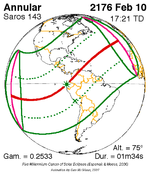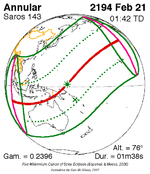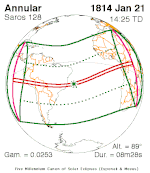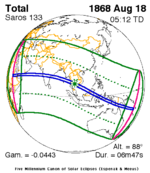| Total eclipse | |
| Gamma | 0.3836 |
|---|---|
| Magnitude | 1.0269 |
| Maximum eclipse | |
| Duration | 157 s (2 min 37 s) |
| Coordinates | 14°06′N123°36′W / 14.1°N 123.6°W |
| Max. width of band | 99 km (62 mi) |
| Times (UTC) | |
| Greatest eclipse | 20:27:27 |
| References | |
| Saros | 143 (21 of 72) |
| Catalog # (SE5000) | 9459 |
A total solar eclipse occurred at the Moon's ascending node of orbit on Wednesday, October 12, 1977, [1] with a magnitude of 1.0269. A solar eclipse occurs when the Moon passes between Earth and the Sun, thereby totally or partly obscuring the image of the Sun for a viewer on Earth. A total solar eclipse occurs when the Moon's apparent diameter is larger than the Sun's, blocking all direct sunlight, turning day into darkness. Totality occurs in a narrow path across Earth's surface, with the partial solar eclipse visible over a surrounding region thousands of kilometres wide. Occurring about 2.6 days before perigee (on October 15, 1977, at 10:00 UTC), the Moon's apparent diameter was larger. [2]
Contents
- Observations
- Eclipse details
- Eclipse season
- Related eclipses
- Eclipses in 1977
- Metonic
- Tzolkinex
- Half-Saros
- Tritos
- Solar Saros 143
- Inex
- Triad
- Solar eclipses of 1975–1978
- Saros 143
- Metonic series
- Tritos series
- Inex series
- Notes
- References
Totality was visible in the Pacific Ocean, Colombia and Venezuela. A partial eclipse was visible for parts of North America, Central America, the Caribbean, and northern South America.











